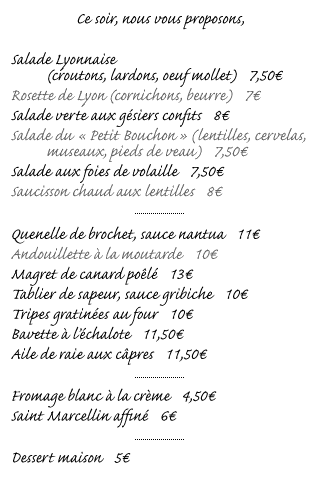|
|
|
|
|
|
|
|
For the traveler to Old Lyon, bouchons may seem ever present. And there’s even a bouchon fan club — Francs Mâchons — made up of the eaters and drinkers who frequent these establishments. But what are bouchons and why are they only in Lyon? Although the term bouchon can be traced back to the Middle Ages, restaurants using the term in their description seem to date only to the nineteenth century. Bouchons are the informal keepers of workers’ cooking, specifically the silk workers — canuts — of the Croix-Rousse district in Lyon — that perhaps may be why bouchons only exist in Lyon. The world of the canuts was essentially snuffed out by bureaucratic regulations in the mid-nineteenth century, but their food traditions is maintained by modern bouchons. Bouchons are not fancy restaurants. They don’t serve fancy food, but their output is nonetheless tasty (and hearty). Here, one can partake in the parts of the pig, sheep, or calf that other restaurants may be reluctant to serve. Stomachs, feet, heads, livers, skin, and ears all make their way to the table in a bouchon, along with many of the traditional Lyonnaise sausages, such as the andouillettes and rosettes. Portions are generally large. More emphasis is placed on the entrées (first courses) and plats (main courses) than on desserts, where a diner is as likely to end his repas with cervelle de canut as with a sweet dessert. |
|
|
|
|
|
|
|
|
On my last visit to Lyon, I shared a very enjoyable meal with Jean-Marc Villard at a bouchon called Au Petit Bouchon “Chez Georges.” M. Villard claims that it is representative of authentic bouchons and one of the best. At Chez Georges, France Deschamps does the cooking while her husband Michel works the front of the restaurant — an arrangement common to many bouchons. The restaurant is located on a narrow street — almost an alley — called rue du Garet. Although “Bouchon Lyonnais” is painted on the front window, it’s difficult to find the name of the restaurant — which is barely visible — when casually passing it. That doesn’t prevent the Deschamps from filling all of the 25 or so seats every lunch and dinner. Also, Au Petit Bouchon “Chez Georges” is one of the twenty members of Authentiques Bouchons Lyonnais, an association of bouchons committed to presenting traditional workers cuisine. Depicted below are the lunch and dinner menus from Au Petit Bouchon “Chez Georges.” Note that many dishes can be found on both menus. (Move your cursor over a menu selection for the English description of the dish. Clicking on a dish displayed in black text will open a recipe for that dish in a new window. Recipes are not provided for dishes listed in gray.) Although very friendly, Mme. Deschamps declined sharing any of her recipes with me, especially for the delightful tripe dish I had just eaten. But later that afternoon while perusing the local bookstores, I found the very recipe I was seeking — hers — published in a local cookbook. |
|
|
|
|
|
|
|
|





